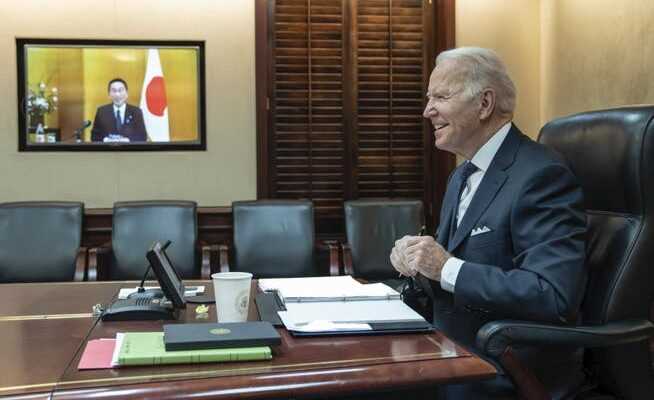The USA and Japan are strengthening industrial policy cooperation.
Japan is already the US’s closest Asian ally. Now both countries also want to work closely together on the subject of “economic security”.
President Biden met with Japanese Prime Minister Fumio Kishida via video link on Jan. 21.
The USA and Japan are already militarily allied. On Friday, US President Joe Biden and Japan’s Prime Minister Fumio Kishida agreed to cooperate more closely on economic security at an online summit. The partners want to supplement their so-called 2+2 talks between foreign and defense ministers with an economic 2+2 meeting between foreign and economic ministers.
The background to the new talks is growing concern about China’s military and economic influence. Both governments want to work more closely together on the reorganization of supply chains and technology development and coordinate their reactions to China’s foreign and economic policy.
The main issues will be supply chains, technology investment and standard setting, Japan’s business daily Nikkei quoted an unnamed senior US official as saying. “We think these are areas where the United States and Japan can step up their game and take a much more active role at such a critical time.”
The attempt to close ranks economically is part of closer security policy cooperation. Biden and Kishida also discussed Russia’s threat to Ukraine and its support for Taiwan towards the People’s Republic of China, which wants to unite the offshore island’s ROC with the mainland by force if necessary. “But I will not go into further details,” said the Japanese head of government at the subsequent press conference in relation to China.
In addition, Kishida invited the American President to a summit meeting in Japan, which is also to be attended by the heads of state and government of the other two members of the so-called Quad, India and Australia. The Quad is a loose association in which the four countries exchange views on security policy in Asia and economic developments.
The alliance of four is part of the American strategy of supplementing previous bilateral alliances with multilateral alliances and global connections in order to build a counterweight to China. One example is the military alliance between Australia, the UK and the US (Aukus), which Japan is moving towards this month through a troop exchange agreement with Australia. Japan also held 2+2 talks with Germany, Indonesia and France this month.
However, economic cooperation is becoming an increasingly important part of the emerging alliance network in Asia. The USA and Japan are among the trendsetters in the attempt to increase security of supply by reorganizing the supply chains and by locating semiconductor and battery factories with state support.
One aspect is reducing dependency on China for many important products and components. Japan has been providing financial support to companies relocating factories from China to Japan or Southeast Asia since 2020.
However, the trend towards economic cooperation also has a military side. The American Navy, for example, has set up a “Japan Tech Bridge” for its large Japanese bases, through which local manufacturers are to be won over as suppliers to the American armed forces.
US Secretary of State Antony Blinken emphasized the geostrategic aspect of the economic and technology partnership in mid-January. “When Japanese and American researchers bring their mutually complementary strengths to bear, we can outperform and outperform each other,” Blinken said after a 2+2 foreign policy talk between the two countries.
